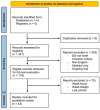Nanoparticle-Based Treatment Approaches for Skin Cancer: A Systematic Review
- PMID: 37622997
- PMCID: PMC10453819
- DOI: 10.3390/curroncol30080516
Nanoparticle-Based Treatment Approaches for Skin Cancer: A Systematic Review
Abstract
Nanoparticles have shown marked promise as both antineoplastic agents and drug carriers. Despite strides made in immunomodulation, low success rates and toxicity remain limitations within the clinical oncology setting. In the present review, we assess advances in drug delivery nanoparticles, for systemic and topical use, in skin cancer treatment. A systematic review of controlled trials, meta-analyses, and Cochrane review articles was conducted. Eligibility criteria included: (1) a primary focus on nanoparticle utility for skin cancer; (2) available metrics on prevention and treatment outcomes; (3) detailed subject population; (4) English language; (5) archived as full-text journal articles. A total of 43 articles were selected for review. Qualitative analysis revealed that nanoscale systems demonstrate significant antineoplastic and anti-metastasis properties: increased drug bioavailability, reduced toxicity, enhanced permeability and retention effect, as well as tumor growth inhibition, among others. Nanoformulations for skin cancers have largely lagged behind those tested in other cancers-several of which have commercialized formulae. However, emerging evidence has indicated a powerful role for these carriers in targeting primary and metastatic skin cancers.
Keywords: drug carriers; inorganic; nanoparticle; organic; skin cancer; systematic review.
Conflict of interest statement
The authors declare no conflict of interest.
Figures




Similar articles
-
Evidence-Based Utility of Adjunct Antioxidant Supplementation for the Prevention and Treatment of Dermatologic Diseases: A Comprehensive Systematic Review.Antioxidants (Basel). 2023 Jul 27;12(8):1503. doi: 10.3390/antiox12081503. Antioxidants (Basel). 2023. PMID: 37627498 Free PMC article. Review.
-
KRAS Testing for Anti-EGFR Therapy in Advanced Colorectal Cancer: An Evidence-Based and Economic Analysis.Ont Health Technol Assess Ser. 2010;10(25):1-49. Epub 2010 Dec 1. Ont Health Technol Assess Ser. 2010. PMID: 23074403 Free PMC article.
-
Advanced targeted therapies in cancer: Drug nanocarriers, the future of chemotherapy.Eur J Pharm Biopharm. 2015 Jun;93:52-79. doi: 10.1016/j.ejpb.2015.03.018. Epub 2015 Mar 23. Eur J Pharm Biopharm. 2015. PMID: 25813885 Review.
-
Drug delivery nanoparticles in skin cancers.Biomed Res Int. 2014;2014:895986. doi: 10.1155/2014/895986. Epub 2014 Jul 2. Biomed Res Int. 2014. PMID: 25101298 Free PMC article. Review.
-
Nanoparticles for topical drug delivery: Potential for skin cancer treatment.Adv Drug Deliv Rev. 2020 Jan 1;153:87-108. doi: 10.1016/j.addr.2020.05.011. Epub 2020 Jun 1. Adv Drug Deliv Rev. 2020. PMID: 32497707
Cited by
-
Gold nanostructures in melanoma: Advances in treatment, diagnosis, and theranostic applications.Heliyon. 2024 Aug 2;10(15):e35655. doi: 10.1016/j.heliyon.2024.e35655. eCollection 2024 Aug 15. Heliyon. 2024. PMID: 39170173 Free PMC article. Review.
-
Arsenic Nanoparticles Trigger Apoptosis via Anoikis Induction in OECM-1 Cells.Int J Mol Sci. 2024 Jun 18;25(12):6723. doi: 10.3390/ijms25126723. Int J Mol Sci. 2024. PMID: 38928430 Free PMC article.
-
Niosomes: Composition, Formulation Techniques, and Recent Progress as Delivery Systems in Cancer Therapy.Pharmaceutics. 2024 Feb 4;16(2):223. doi: 10.3390/pharmaceutics16020223. Pharmaceutics. 2024. PMID: 38399277 Free PMC article. Review.
-
Advances in Materials Science for Precision Melanoma Therapy: Nanotechnology-Enhanced Drug Delivery Systems.Pharmaceutics. 2025 Feb 24;17(3):296. doi: 10.3390/pharmaceutics17030296. Pharmaceutics. 2025. PMID: 40142960 Free PMC article. Review.
-
Microwave assisted drug delivery of titanium dioxide/rose Bengal conjugated chitosan nanoparticles for micro-photodynamic skin cancer treatment in vitro and in vivo.BMC Cancer. 2025 May 19;25(1):896. doi: 10.1186/s12885-025-14285-8. BMC Cancer. 2025. PMID: 40389852 Free PMC article.
References
-
- Melanoma Skin Cancer Statistics. [(accessed on 14 April 2023)]. Available online: https://www.cancer.org/cancer/melanoma-skin-cancer/about/key-statistics.....
Publication types
MeSH terms
LinkOut - more resources
Full Text Sources
Medical

